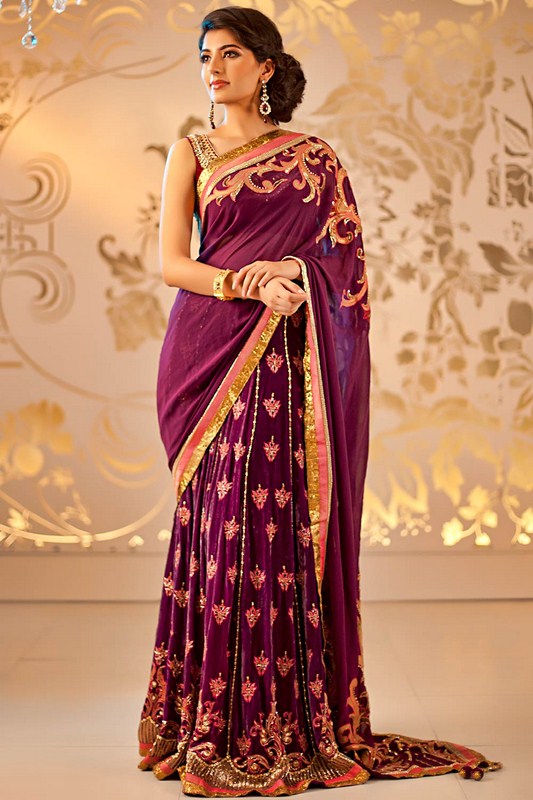Indian Saree Biography
Source(Google.com.pk)
Sari
A saree, sari or shari is a South
Asian female garment that consists of a drape varying from
five to nine yards in length and two to four feet in
breadth that is typically wrapped around the waist, with one end draped over
the shoulder, baring the midriff.
The sari is usually worn over a petticoat (called 'parkar' (परकर) in Marathi lahaṅgā orlehenga in the north; pavadai in Tamil, pavada (or occasionally langa) in bothKannada and Telugu, chaniyo, parkar, ghaghra, or ghagaro in the west; and shayain eastern India), with a
fitted upper garment commonly called a blouse (ravika in thesouth and choli elsewhere. The blouse has short
sleeves and is usually cropped at the midriff. The sari is associated with
grace and is widely regarded as a symbol of Indian, Bangladeshi and Sri
Lankan culture.
Styles of draping
Illustration of different styles of
sari & clothing worn by women in South Asia
There are
more than 80 recorded ways to wear a sari. Fashion
designer Shaina NC declared,"I can drape a sari
in 54 different styles".
The most
common style is for the sari to be wrapped around the waist, with the loose end
of the drape to be worn over the shoulder, baring the midriff. However, the sari can be draped in
several different styles, though some styles do require a sari of a particular
length or form. The French cultural anthropologist and sari researcherChantal Boulanger categorised sari drapes in the
following families:
Nivi – styles originally worn in Andhra
Pradesh; besides the modern nivi, there is also the kaccha nivi, where the pleats
are passed through the legs and tucked into the waist at the back. This allows
free movement while covering the legs.
Bengali and Oriya style.
Gujarati/Rajasthani – after tucking in the pleats similar
to the nivi style, the loose end is taken from the back, draped across the
right shoulder, and pulled across to be secured in the back
Woman in chiffon, silk andmuslin-
Dhaka, Bangladesh
Maharashtrian/Konkani/Kashta;
This drape is very similar to that of the male
Maharashtrian dhoti. The center
of the sari (held lengthwise) is placed at the center back, the ends are
brought forward and tied securely, then the two ends are wrapped around the
legs. When worn as a sari, an extra-long cloth of nine yards is used and the
ends are then passed up over the shoulders and the upper body. They are
primarily worn by Brahmin women ofMaharashtra, Karnataka, Andhra Pradesh and Goa.
Madisar –This
drape is typical of Iyengar/Iyer Brahmin ladies from Tamil Nadu. Traditional
Madisar is weared using 9 yards saree.
Kodagu style –
This drape is confined to ladies
hailing from the Kodagu district ofKarnataka. In this style,
the pleats are created in the rear, instead of the front. The loose end of the
sari is draped back-to-front over the right shoulder, and is pinned to the rest
of the sari.
Gobbe Seere –
This style is worn by women in the
Malnad or Sahyadri and central region of Karnataka. It is worn with 18 molas
saree with three four rounds at the waist and a knot after crisscrossing over
shoulders
Gond –
Sari styles found in many parts of
Central India. The cloth is first draped over the left shoulder, then arranged
to cover the body.
Malayali style –
The two-piece sari, or Mundum Neryathum, worn in Kerala. Usually made of unbleached
cotton and decorated with gold or coloured stripes and/or borders. Also the Set-saree, a sort of mundum neryathum.
Tribal styles –
Often secured by tying them firmly
across the chest, covering the breasts.
Kunbi style or denthli:
Goan Gauda
and Kunbis,and those of them who have migrated to other states use this way of
draping Sari or Kappad,this
form of draping is created by tying a knot in the fabric below the shoulder and
a strip of cloth which crossed the left shoulder was fasten on the back.
Similarities and differences with other Asian clothing
While the sari is typical to Indian traditional wear, clothing worn by South-East Asian countries like Burma, Malaysia, Philippines, and Singapore resemble it, where a long rectangular piece of cloth is draped around the body. These are different from the sari as they are wrapped around the lower-half of body as a skirt, worn with a shirt/blouse, resembling a sarong, as seen in the Burmese Longyi, Filipino Malong, Tapis, Laotian Xout lao, Thai Sinh's, and Timorese Tais. Saris
Indian Saree Indian Lehnga Dress Suites Design 2014 Choli Photos Pics Images Wallpapers
Indian Saree Indian Lehnga Dress Suites Design 2014 Choli Photos Pics Images Wallpapers
Indian Saree Indian Lehnga Dress Suites Design 2014 Choli Photos Pics Images Wallpapers
Indian Saree Indian Lehnga Dress Suites Design 2014 Choli Photos Pics Images Wallpapers
Indian Saree Indian Lehnga Dress Suites Design 2014 Choli Photos Pics Images Wallpapers
Indian Saree Indian Lehnga Dress Suites Design 2014 Choli Photos Pics Images Wallpapers
Indian Saree Indian Lehnga Dress Suites Design 2014 Choli Photos Pics Images Wallpapers
Indian Saree Indian Lehnga Dress Suites Design 2014 Choli Photos Pics Images Wallpapers
Indian Saree Indian Lehnga Dress Suites Design 2014 Choli Photos Pics Images Wallpapers
Indian Saree Indian Lehnga Dress Suites Design 2014 Choli Photos Pics Images Wallpapers
Indian Saree Indian Lehnga Dress Suites Design 2014 Choli Photos Pics Images Wallpapers
Indian Saree Indian Lehnga Dress Suites Design 2014 Choli Photos Pics Images Wallpapers
Indian Saree Indian Lehnga Dress Suites Design 2014 Choli Photos Pics Images Wallpapers
Indian Saree Indian Lehnga Dress Suites Design 2014 Choli Photos Pics Images Wallpapers
Indian Saree Indian Lehnga Dress Suites Design 2014 Choli Photos Pics Images Wallpapers
Indian Saree Indian Lehnga Dress Suites Design 2014 Choli Photos Pics Images Wallpapers
Indian Saree Indian Lehnga Dress Suites Design 2014 Choli Photos Pics Images Wallpapers
















No comments:
Post a Comment